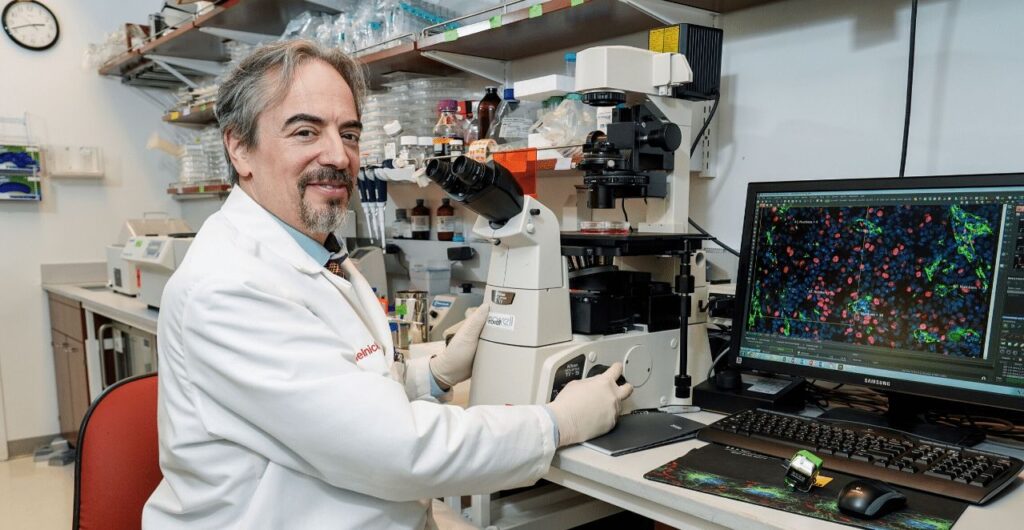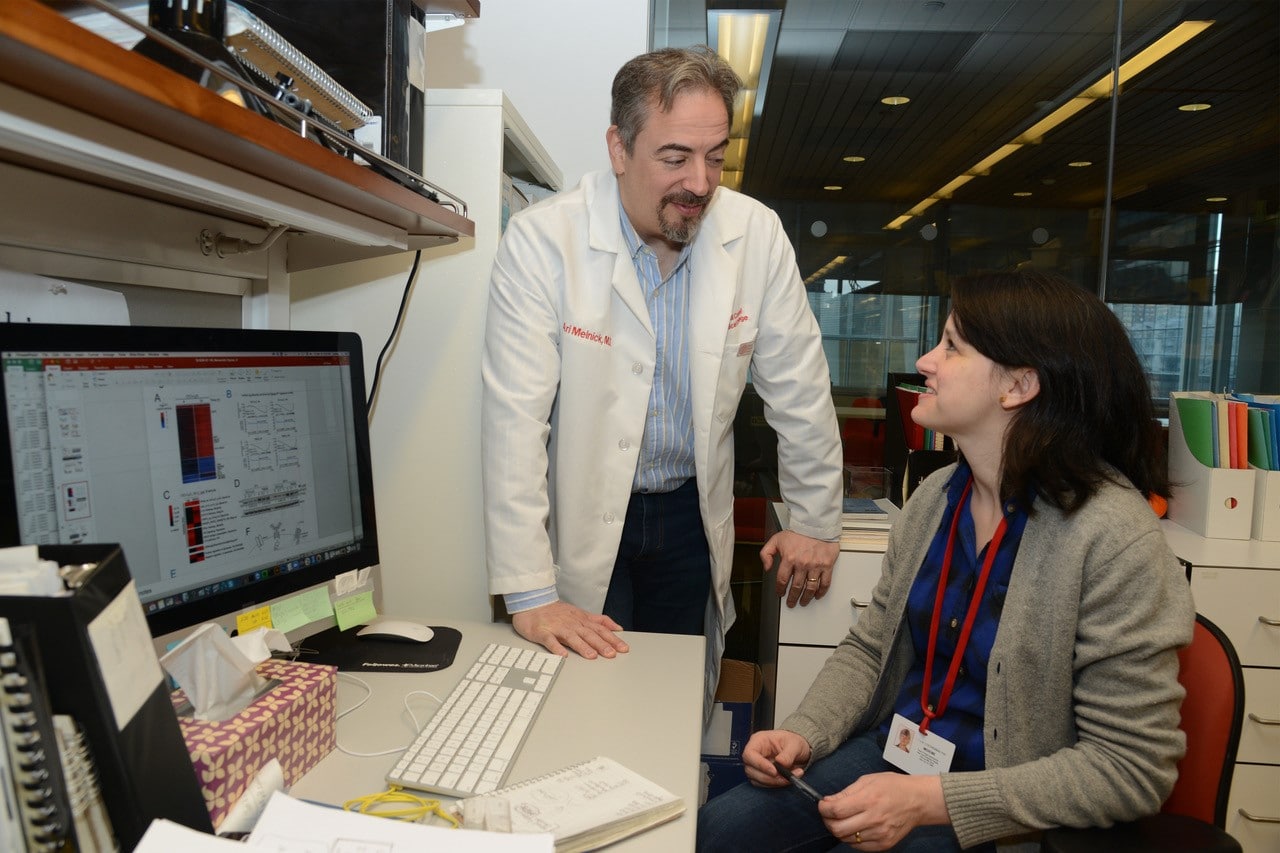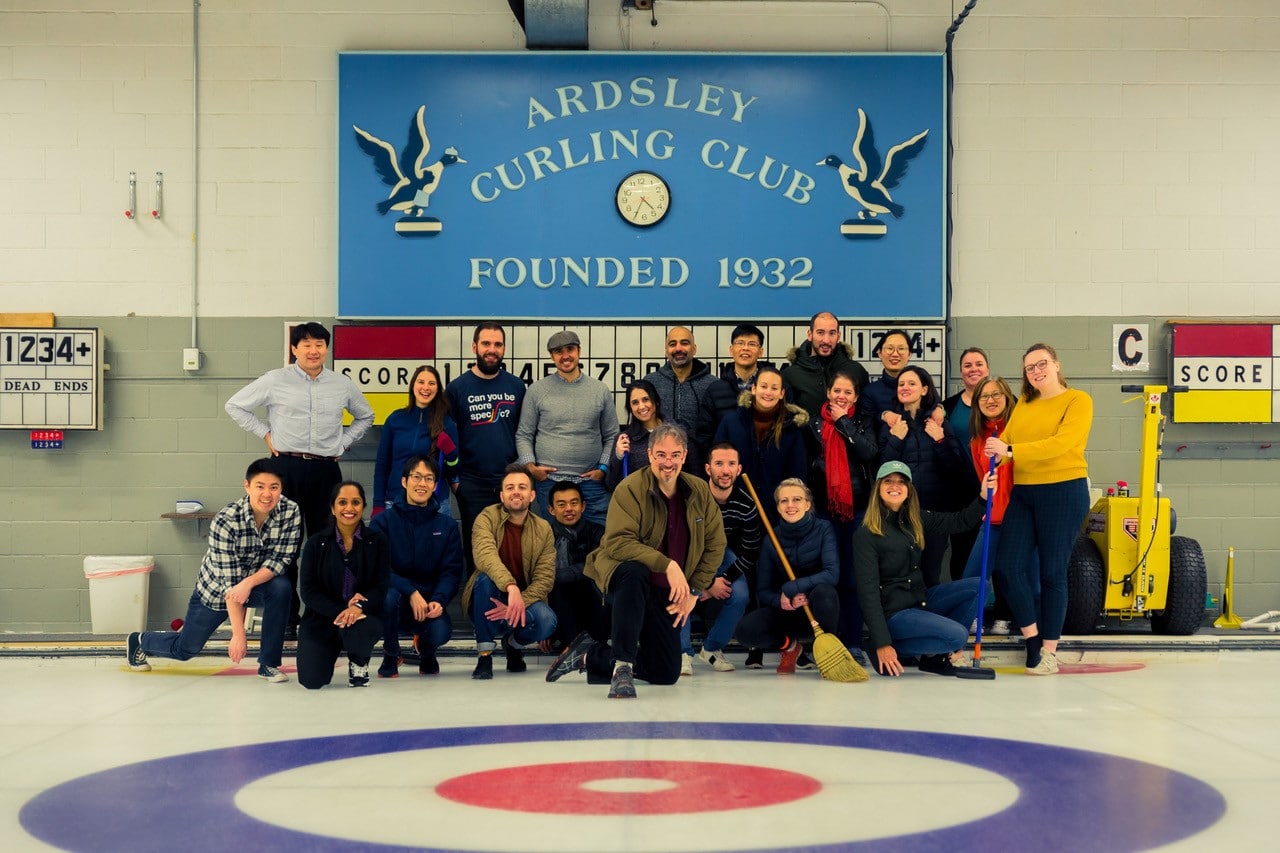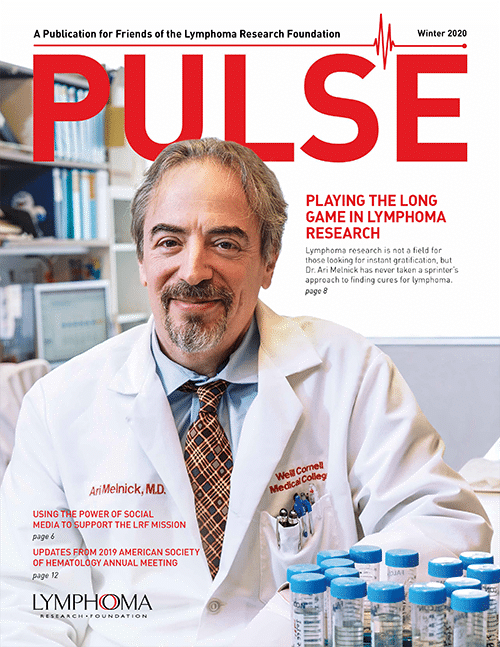Playing the long game is not a new concept for Lymphoma Research Foundation Grantee and Scientific Advisory Board (SAB) member Ari Melnick, MD, of NewYork-Presbyterian/Weill Cornell Medicine. Lymphoma research is not a field for those looking for instant gratification, but Dr. Melnick has never taken a sprinter’s approach to finding cures for lymphoma. He is more of a marathoner.
 Dr. Melnick in his research lab
Dr. Melnick in his research lab
When you look around Dr. Melnick’s office on the Upper East Side of Manhattan, you can’t help but notice a gigantic model replica of the Millennium Falcon from Star Wars. Dr. Melnick approaches research with the same patience and attention to detail that it seemingly took to put together that model, and with an equally innovative view of the future.
FROM DANCE TO HEMATOLOGY
Born in Argentina, Dr. Melnick spent most of his adolescent and young adult life with a love of dance—even directing his own dance company. However, his true passion always lay in medicine and understanding the nature of disease. This passion led him to attend medical school in Argentina and later move to the United States for clinical training in internal medicine.“I had read in one of my pathology textbooks about a hospital in New York [Mount Sinai Hospital] where certain diseases were being discovered, and so I thought, ‘Wow, that must be the best place to go,’” says Dr. Melnick.
“I felt that hematology presented an opportunity to have a deeper understanding of medicine at the molecular level.”
He completed his clinical training in internal medicine and decided to pursue a specialty in hematology/oncology. “I became very interested in hematology because it is, and perhaps always has been, the most molecularly advanced area in all of medicine,” he says. “I felt that hematology presented an opportunity to have a deeper understanding of medicine at the molecular level.”
Starting his career as an oncologist, Dr. Melnick worked to support patients and their families during a despairing time in their lives—a job that he found to be both tough yet rewarding. “[At the time] we weren’t able to cure many patients, but we could at least be there for them, as someone who they could rely on,” he says.
However, after years of diagnosing patients and treating them with chemotherapy “recipes,” he felt that there had to be a better way to have an impact on patients with cancer. “A patient would come in with a potential cancer. You get a biopsy, you figure out what tissue it corresponds to, do a series of tests to determine disease stage, and then there’s a recipe for what chemotherapy to give—it all felt medieval,” says Dr. Melnick.
Dr. Melnick realized that in order to make a significant change in the way patients were treated, there would first need to be a better understanding of how these diseases work. His thought was that if he could discover the molecular basis causing cancer to occur, he could then produce much more powerful and less toxic treatments that could eradicate it. “I was fascinated with understanding the disease and disease mechanism, and thought understanding this could help us achieve more targeted treatments,” he adds.
“I was fascinated with understanding the disease and disease mechanism, and thought understanding this could help us achieve more targeted treatments.”
He made the decision to switch gears from clinician to researcher, with the willingness and drive to devote his career to developing mechanisms that could treat cancers at their source. “I was okay with the idea that I may never have a direct impact on a patient, because the top priority is to understand what cancer is, which is required in order to then successfully cure it,” he says.

Dr. Melnick with LRF grantee, Lorena Fontan-Gabas, PhD; Dr. Melnick sponsored Dr. Fontan-Gabas’ LRF Fellowship
BREAKTHROUGH AND VALIDATION
A few years later, Dr. Melnick experienced a breakthrough in his lab that would completely validate his choice to enter the field of lymphoma research. He and his team discovered the mechanism through which a master regulatory protein called B-cell lymphoma 6 (BCL6) drives lymphoma: “[The protein] is acting like the airport marshallers who stand on the runway with lights to direct planes to their proper docking sites,” says Dr. Melnick. “Its main function is to bind to thousands of genes where it brings in cellular machinery to control these genes.” He reasoned that by defining the precise biochemical mechanism through which this occurs, it would be possible to develop BCL6 inhibitors. The problem was that no one had ever developed a drug that was able to target a master regulatory protein like BCL6, which was thought to be “undruggable.”
Dr. Melnick’s team used this information to develop inhibitors that could block the ability of lymphoma cells to use BCL6. They began by creating biochemical decoys and, much to their surprise, the decoys completely wiped out any trace of lymphoma cells. “It was a validation that I didn’t expect,” he says. “I didn’t think that could happen in less than 20 years, and we made it happen in six months.” The decoys worked effectively as BCL6 inhibitors—a major turning point in Dr. Melnick’s research and an impetus for the research he still conducts today.
DIVERSITY IS STRENGTH
A key element to the success of Dr. Melnick’s lab is the collaborative, friendly and warm environment that he works hard to maintain. He feels strongly that the researchers in his lab work collaboratively, and finds that better science is done when people work together as a team. He and his colleagues even participate in team-building activities to foster creativity and encourage brainstorming. “Playing games actually helps brainstorming be more effective,” he says. Dr. Melnick also believes in the importance of diversity and multiculturalism throughout his team.
 Dr. Melnick with his research team members including LRF grantee Martin Rivas, PhD (standing); Dr. Melnick sponsored Dr. Rivas’ LRF Fellowship
Dr. Melnick with his research team members including LRF grantee Martin Rivas, PhD (standing); Dr. Melnick sponsored Dr. Rivas’ LRF Fellowship
“Science is a wonderful field because it is inherently so cosmopolitan. One of the beauties of science is that it provides a basis for people to cross-cultural and ethnic barriers and discover their shared humanity,” he says. He believes diversity can inspire better, more impactful research and presents the researchers an opportunity to explore their work through multiple different lenses.
“Mentoring is not about telling people what to do, but rather, enabling them to take advantage of their inner strengths and passion for science and improving the lives of people with cancer.”
Mentoring the next generation of lymphoma researchers is also of the utmost importance to Dr. Melnick, and he says it is one of his favorite parts about his job. “Mentoring is not about telling people what to do, but rather, enabling them to take advantage of their inner strengths and passion for science and improving the lives of people with cancer,” he says.
As if mentoring the researchers in his lab wasn’t enough, Dr. Melnick has also volunteered as mentoring faculty for LRF’s Lymphoma Clinical Researchin the Mentoring Program (LCRMP), the first and only early-career mentoring program focused exclusively on clinical researchers in lymphoma. He has sponsored four LRF Postdoctoral Fellowship grantees as well. Dr. Melnick relishes in the “aha moments” that come out of his lab and says that seeing his mentees make scientific discoveries based on their own ideas and initiative is a main driver of satisfaction and happiness of his profession.
LOOKING TOWARDS A CANCER-FREE FUTURE
Currently, Dr. Melnick and his team are developing ways to identify the master regulatory proteins that can “reprogram” the immune system to form lymphomas and dissect out their molecular mechanisms of action. “It’s very rewarding because it gives you a dramatic insight into the incredible ways in which the immune system works, the complex and intricate process of lymphomagenesis and most importantly, the ability to develop ways to better treat these tumors,” he says.
 Dr. Melnick and Team on retreat
Dr. Melnick and Team on retreat
Though the pace of science can sometimes be “dizzying” for Dr. Melnick, he also sees much promise for the future and believes that recent technological and conceptual advances represent a “new frontier” for researchers. “For the first time, we’re able to study lymphomas from a holistic, systemic standpoint,” says Dr. Melnick. “From lymphoma cells to the cells that help them, to the cells that are supposed to stop them—at the single-cell level—we can actually see it all happening.”
Given the rapid and accelerating pace of discovery, Dr. Melnick underlines that it is difficult to predict how rapidly these new advances will translate to the clinic, although one thing that has always been clear to him is the reason he began doing research in the first place. “Nature is stranger and more exciting than humans can imagine, so when you see it unfold, it is invariably stunning and beautiful,” he says. Yet for Dr. Melnick, it all harkens back to his time as a clinician when he would meet with families whose lives had been impacted by cancer.
As a researcher, he feels a palpable responsibility to ensure a brighter future for patients, survivors and their loved ones. He obtains the most satisfaction from meeting patients who have benefited from a discovery that he participated in and experiences great joy from seeing people who have gone through treatment and have come out on the other side healthy and without toxicity. “The moments that really make it worth all the pain and sacrifice is when you realize that you’ve figured something out and see how it can play out in medicine and improve the lives of cancer patients,” he says. “There is nothing like that.”
Read more articles and updates in the latest issue of Pulse
Pulse is a publication of the Lymphoma Research Foundation, providing the latest updates on the Foundation and its focus on lymphoma and chronic lymphocytic leukemia (CLL) research, awareness and education. Read more >
 Dr. Melnick in his research lab
Dr. Melnick in his research lab
 Dr. Melnick with his research team members including LRF grantee Martin Rivas, PhD (standing); Dr. Melnick sponsored Dr. Rivas’ LRF Fellowship
Dr. Melnick with his research team members including LRF grantee Martin Rivas, PhD (standing); Dr. Melnick sponsored Dr. Rivas’ LRF Fellowship Dr. Melnick and Team on retreat
Dr. Melnick and Team on retreat